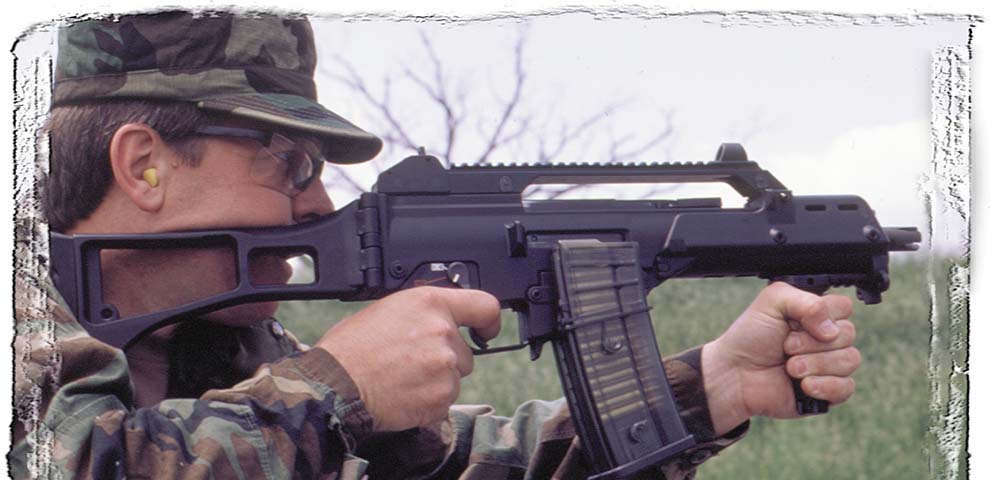By Jim Schatz
October 17th, 1977. The men of GSG 9 approach the Lufthansa 707 jetliner from behind. At 00.05 hours on the code word “magic fire” the operators begin their assault up rubber-coated alloy ladders into the aircraft. By 00.07 hours evacuation of the hostages begins as a battle rages in the cockpit. In the end GSG 9 overpowers the four Palestinian terrorists, all 90 hostages are freed. Only one GSG 9 member is wounded. During this operation much of the world learned for the first time of the capabilities of a new age anti-terrorist force. It was also the first time for many that the HK MP5 Submachine Gun was seen in the hands of such a unit.
If it can be said that the successful hostage rescue mission by the GSG 9 in 1977 introduced the world to the MP5 submachine gun, Operation Nimrod conducted by the British Special Air Service on May 5th, 1980 literally catapulted the MP5 submachine gun into the worldwide recognition it still enjoys today as the world’s premier close quarters combat weapon. Transmitted by the news services around the world, this highly successful and publicized hostage rescue occurred at the Iranian Embassy located at No. 16 Princes Gate in London. Black Nomex clad members of the SAS Counter Revolutionary Wing (CRW) rappelled from the upper floors of the embassy for all to see armed with the sleek yet deadly German-made MP5’s.
Designed in 1964 the MP5 was already more than 15 years old when the Brit’s success at Princes Gate was recorded for the history books. Since the early 1980’s the MP5 has become the submachine gun of choice for elite military and law enforcement units around the world. The MP5 user’s list is a who’s who in the world of anti-terrorism and hostage rescue organizations, some even from the former Soviet Union. Even the most recently publicized hostage rescue operation, conducted perfectly by the experienced Baltimore County Maryland Tactical Team, of three family members in Dundalk, Maryland this year was ended with on target bursts of two MP5SD’s. A seasoned military operator once stated to this writer that he was sure the MP5 had more terrorist “kills” than any other single weapon. The MP5 lives on today, more than 3 decades since its creation, as the sub gun of choice for those still carrying pistol-caliber CQB “long guns”.
The Winds of Change Blow from the West
As early as 1985 various elite units in the U.S. military contacted HK to evaluate small compact rifle-caliber weapons for CQB purposes in calibers 5.56X45mm and 7.62X51mm. Numerous requests from these same units for HK to build the MP5 in .45 ACP caliber were unsuccessful for economic reasons. For a time the 5.56mm select-fire HK53 Carbine and 7.62mm G3K, the MP5’s bigger brothers, were hot items as possible replacements to the 9mm MP5. Many units in the U.S. purchased limited numbers of HK53’s and HK33K’s for use in the classic CQB role as a supplement to or outright replacement for the pistol-caliber MP5.
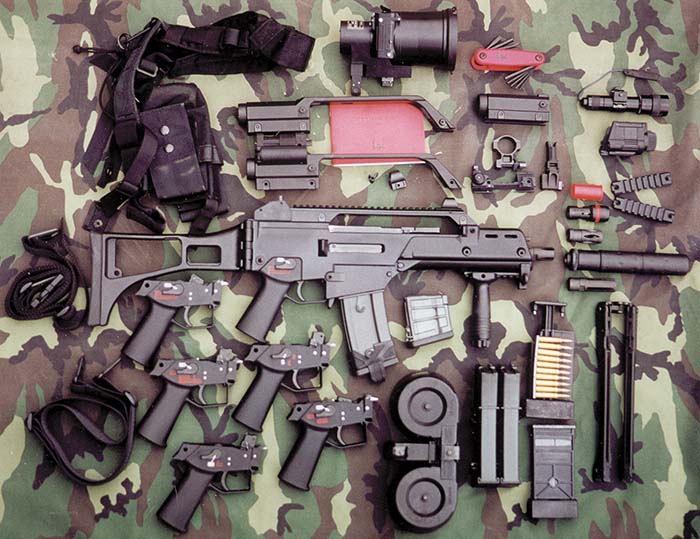
The reasons for this evolution are fairly straightforward, and still certainly valid for today’s tactical personnel. Users learned that the 9mm submachine gun was simply incapable of dealing with hard targets such as individuals wearing body armor or vehicles due to the limited terminal performance of the 9X19mm Parabellum cartridge. In addition teams armed only with submachine guns were in a bad way against their opponents armed with assault rifles, especially when moving over land to and from target locations. Outgunned basically, a transition from pistol-caliber submachine guns to rifle-caliber weapons offered the operator far greater capabilities against soft and hard targets at 2-4 times the maximum effective range of the typical pistol-caliber sub gun.
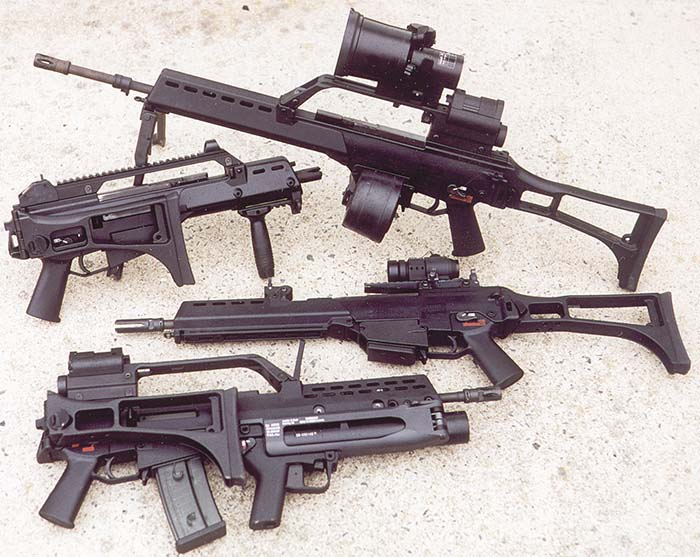
While some have questioned the use of rifle-caliber weapons in the Close Quarters Battle role many special operations units have already transitioned to 5.56mm M4 Carbine variants for this role as far back as the early 1990’s. Issues with bullet performance at close range, over penetration and ricochet against building materials have to some extent been successfully addressed with relatively recent developments in the design of new cartridges and projectiles. Today many units are even carrying 5.56mm CQB weapons that can be effectively suppressed with advanced and durable sound suppressors and subsonic 5.56X45mm ammunition loaded with extremely heavy projectiles in excess of 150 grains.
This trend towards rifle-caliber CQB weaponry, mostly in 5.56X45mm caliber, has made its way also into federal law enforcement and to a lesser degree some state and local agencies as well. Many teams have traded in or disposed of their trusty MP5’s for a varying assortment of .223 weapons. The proliferation of the M16/M4 weapons system throughout U.S. military and law enforcement communities clearly provides the impetus to the adoption of what were once considered only perimeter weapons to “inside” guns firing rifle ammunition. For reasons of unit price but more notably simple familiarization and availability, HK fared rather poorly against the gas-operated M16/M4 weapons until the advent of the new G36 weapons system.
The Gay Sechs und Dreizig (G36) Arrives
HK’s contenders since the early 1970’s were the HK33 rifle, HK33K Carbine and miniature HK53 “Submachine Gun” as it has sometimes been called due to its size, only 2 inches longer than the 9mm MP5. The FBI Hostage Rescue Team utilized the HK33K for many years during the 1980’s as perimeter guns while the 9mm MP5’s performed the inside CQB duties. GSG 9 and the British SAS adopted the HK53 for missions where compact 5.56mm firepower and performance was required, in the case of the Germans against vehicles where the 9mm MP5 had proven less than effective. HK53’s have been issued with select special operations units due to their near identical operation and handling characteristics compared to the MP5 sub gun. However, as good as the roller-locked HK rifles were, units who were already using some variant of the M16 still often overlooked them.
Americans favor rifles wherein the bolt locks open on the last round fired. The roller-locked HK rifles do not. No degree of technical justification can change that. HK33’s and HK53’s also require special blank ammunition to operate the delayed blowback bolts and muzzle devices for firing frangible ammo. They are also not supported by the military supply system or aftermarket accessory industry like countless variants of Eugene Stoner’s creation. Higher unit costs of HK33’s and HK53’s and support parts and tools also made the adoption of the roller-locked HK 5.56mm rifles a costly venture, one out of the financial pockets of most organizations.
With the arrival of the new HK G36, driven by the German military’s need for a lightweight, affordable and conventional 5.56mm rifle for their forces operating with NATO in Bosnia, many if not all of the issues that held back the roller-locked HK33 and HK53 disappeared.
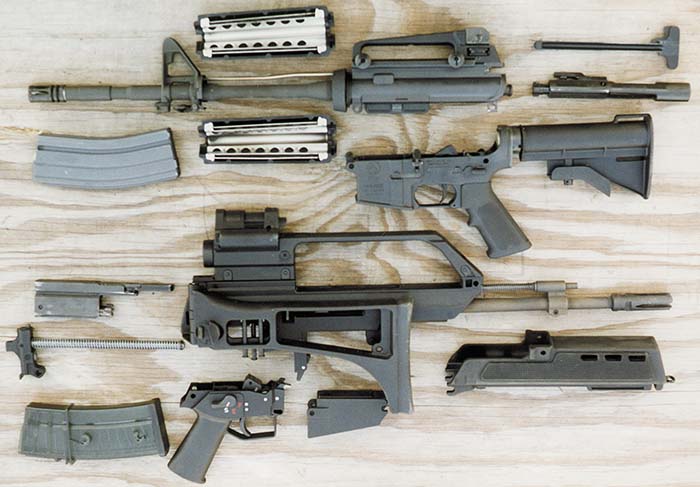
In 1990 the G36 development began at HK. In 1995 the German Bundeswehr (Armed Forces) officially adopted the G36. Within the same year the newly formed German Special Operations Unit, KSK, arrived on HK’s doorstep in Oberndorf with a request to make the G36 rifle shorter. 90 days later the first G36K Carbines rolled of the assembly lines fitted with 12.5 inch barrels. Not looking to be outdone by its competition HK responded to a requirement released by the GSG 9 in 1999 for an even smaller, sub- machine gun sized 5.56mm weapon. This user request drove the development of the latest variant of the G36 weapons system, the new G36 C. Ironically the unit that first placed confidence in the MP5 in the mid-1970’s, GSG 9, would drive the development of a weapon that could be the potential successor to the MP5, and one chambered for a rifle round.
Full circle
With all the tactical advantages of the rifle-caliber CQB weapon there was a price to pay in the important area of size, weight and most importantly maneuverability in the close confines of the typical CQB structure. Fully loaded and outfitted with tactical light, sound suppressor and reflex sight today’s M4 carbine or HK53 for example can easily exceed 8 pounds or more. The excessive overall length of the weapon makes quick movement through the tight confines of CQB targets more difficult than can be managed with shorter, lighter submachine gun. The MP5 is famous for it’s overall “shootability”. The MP5 is fast and easy to be accurate with due to its unique roller-locked breech and closed bolt design, rifle-like configuration and excellent sights and trigger. The short overall length of the MP5 pays huge dividends in a weapon that can swing laterally quickly and effortlessly from target to target like a 20 gauge trap gun does compared to a larger, heavier 12 gauge- for instance. In the eyes of most professional operators only the handgun is faster that the MP5 for engaging multiple targets spread throughout a room.
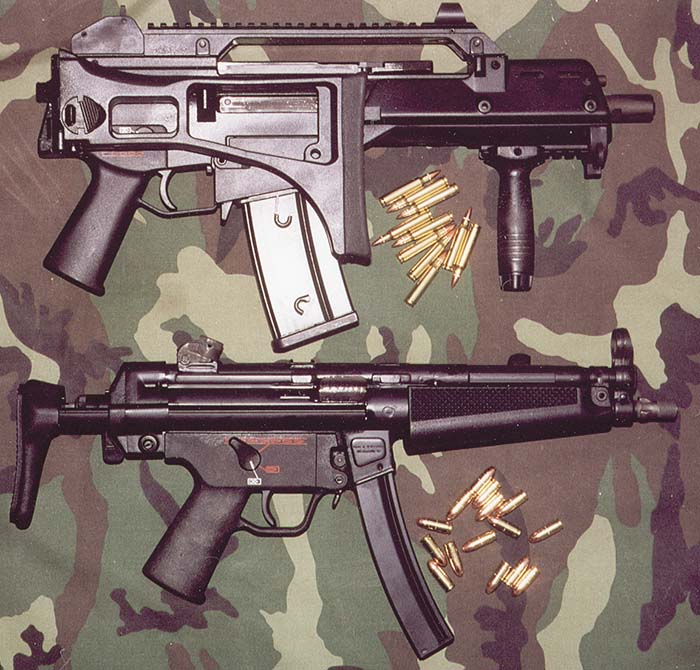
Today, in fact for the past 10 years, rifles have shrunk in size to meet this growing worldwide demand for compact rifle-caliber weapons. In 1989 there were less than 6 Miniature Assault Rifles, today there are more than 30 from numerous different countries around the world. For the purposes of this article a Mini Assault Rifle is defined as a rifle-caliber weapon with a barrel length under 12 inches, an overall length of under 30 inches and weighing less than 7 pounds. These weapons are often seen in VIP protection details, during vehicle operations, by special police units and during hostage rescue missions.
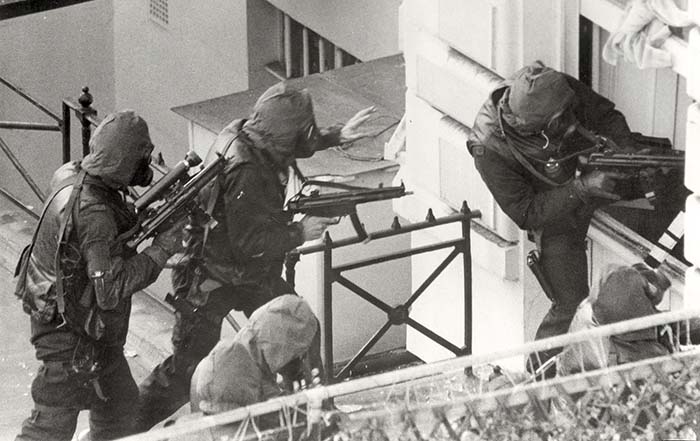
The Mini Assault Rifle (MAR) today provides the handiness and fast action of the submachine gun but with the ballistic and terminal performance approaching that of full size assault rifles. Providing muzzle velocities from 2,100 to up to 2,600 feet per second or more the terminal performance of a 5.56mm projectile from the MAR even at these reduced velocities is deadly effective, even against hardened targets and targets at ranges out to and exceeding 300 meters. The shooter can now fight to, from and inside the target with the same small handy weapon. Once inside, the operator is not handicapped by an overly long or large weapon resulting in fast and surgical target engagement. The Mini Assault Rifle of the late 1990’s appears destined to be the submachine gun of the late 1970’s.
The G36 C. The MP5 replacement?
In many cases and for many potential users the answer may be yes. The HK G36 has already proven itself to be a truly modern, reliable and clean shooting gas-operated weapon. Already issued to the armies of Germany and Spain the G36 has done extremely well in the shrinking world small arms market. The modular receiver design allows various interchangeable barrel assemblies to be fitted to it by the user unit using only simple tools. Barrel lengths include the 18.9 inch rifle barrel, 18.9 inch light support weapon barrel with heavy profile, the new 15.4 inch intermediate barrel with 1/9 inch twist, 12.5 inch carbine barrel and the latest G36 tube, the 8.9 inch G36 C barrel.
The G36 is small and handy. In fact at just over 6 pounds the G36 C is a full inch shorter than the 9mm MP5A3 with their buttstocks extended. With the stocks closed the C is more than 1.5 inches shorter than the MP5A3. The use of advanced polymer materials and side folding stock make for a lightweight and highly portable weapon. To shorten the G36 C, one inch was removed from the folding buttstock and a shortened yet effective 4-prong flash hider was created to tame the muzzle blast common with short barreled rifle-caliber weapons. The right side folding stock allows the weapon to be carried covertly under a light jacket in a special concealed shoulder carrying rig. Spent cases are ejected through the skeletonized stock for use when fired from the confines of a vehicle compartment or aircraft cockpit.
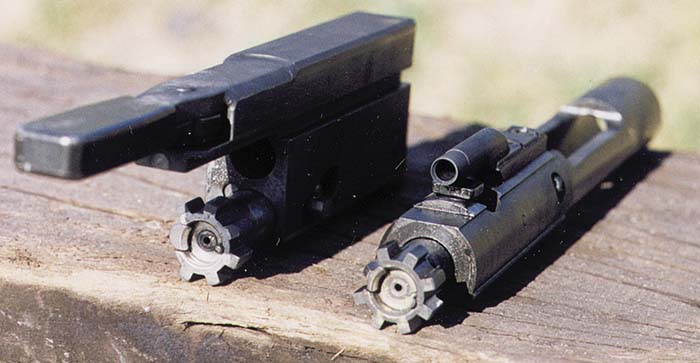
Even with the shortened barrel the G36 C provides @ 2,400 fps muzzle velocity from 55 grain M193 and 62 grain M855 ammunition with muzzle energies ranging from 675 to 775 foot pounds. For comparison, standard 9mm ball ammunition fired from the MP5 steps out at @ 1,200 f.p.s. and provides a modest 383 foot pounds of energy on target. The MP5 can also not defeat most soft or hard body armor using conventional projectiles nor will it reliably perforate vehicle body panels as will the 5.56X45mm cartridge.
Where the MP5 was lacking in areas of user friendliness, the designers of the G36 C listened intently to the comments of the prospective users. The highly desired bolt catch never available on the 9mm MP5 is standard equipment on the G36. Like every G36 operating control, to include the safety/selector lever, magazine release, cocking handle and forward assist, the bolt catch button is also fully ambidextrous. It can even be switched off for those who prefer the bolt to close on an empty magazine. A common complaint of the MP5 has been the location and shape of the safety/selector levers. Hard to actuate without adjusting the grip of the firing hand, the G36 provides a much-improved rendition that pleases most every user regardless of hand size or flexibility.
The clean shooting short stroke gas piston system utilized in the G36 and the C variant brings almost no carbon fouling into the receiver of the weapon. This saves on cleaning time and reduces potentially fatal stoppages, the worst event that can occur in the middle of a CQB mission. This unique feature also guarantees reliability even after prolonged shooting sessions or under adverse conditions. As a result of HK endurance and reliability testing it has been proven that G36’s will run without incident, without cleaning or lubrication for more than 15,000 rounds.
Like the MP5, options abound
The G36 C provides the user with a host of options. Realizing that every unit and in fact many individual shooters desire specific options for the intended mission, the G36 offers modular sight systems, molded-in threaded hard points for accessory and a rail attachment on the forearm and five optional trigger groups.
The G36 C comes standard fitted with a long Picatinny rail “carrying handle” with adjustable iron sights. This rail provides a long landing strip for almost any assortment of sights and targeting devices, used alone or in tandem. Being quick detachable, the rail can be removed and optional optical, folding iron and dual sights installed with no special tools. Tritium night sights of course are available as options.
Tactical lights, lasers and vertical foregrips can be arranged on the G36 C at the discretion of the shooter on one or three sets of molded-in threaded hard points positioned on the left, bottom or right sides of the detachable ventilated forearm. Accessory polymer MIL-STD-1913 rails can be attached to the hard points with Allen screws. These rails then accept most any accessory designed to fit this now universal mounting rail, including those in the U.S. SOPMOD accessory kit for the M4 Carbine.
Tough act to Follow
Will the new HK G36 C totally replace the venerable MP5 in the CQB role? It is highly unlikely considering the Government issue abundance and universal familiarity of the current M4 and M4A1 Carbines. However, time will tell if the advantages of a sub gun size 5.56m CQB weapon can win out over issue carbines available to most users at less than half the unit price of one G36 C.
| This article first appeared in Small Arms Review V4N8 (May 2001) |



